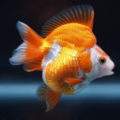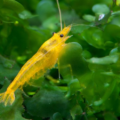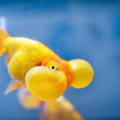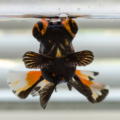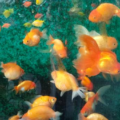This comprehensive care guide for the Telescope Eye Goldfish teaches you everything you need for proper breeding techniques, tank setups, feeding, and much more!

Welcome back, aqua lovers! Today, we’re reviewing one of the most unique goldfish breeds, particularly popular for its large eyes — the Telescope Eye goldfish or Telescope goldfish.
This aquarium goldfish is known for its large, protruding eyes, distinctive body shape, and elongated, flowing fins, making it one of the most popular fancy fish in community aquariums.
The Telescope Eye’s origins date back to old China, as this breed was originally part of the Prussian carp. If you want to know all about caring for the Telescopic Eye goldfish in the modern day, including its specific diet and health care, keep reading.
History and Origins
But first, some Telescope Eye Goldfish history. This unique eyed goldfish traces its origins to Far Eastern China about 300 years ago!
It’s one of the popular Chinese goldfish breeds, bred with all attention to its protruding Eyes, amongst other peculiarities, which earned it the name “dragon eyes.”
In the late 1700s, the Japanese further developed this breed, and in no time, it found its way to the Western world. Western exportation increased the popularity of the telescopic eye goldfish and cemented its place in ornamental fish history.
Physical Characteristics of Telescope Eye Goldfish

The Telescope Eye Goldfish’s appearance is striking and distinguished by its unique physical characteristics, like its eye structure and coloration.
It has large eyes protruding from the head laterally, earning it the name “telescope eye,” and a rounded egg-shaped body about 6 inches long.

This species has a goldfish body structure, like other variants. It usually comes in red, white, black, blue, and yellow and bi-colored or tri-colored patterns with metallic sheened scales that shimmer in gold, silver, and bronze shades.
Ideal Tank Conditions for Telescope Eye Goldfish

Now, let’s discuss the required Telescope Eye goldfish tank conditions so you know how to maintain your pet.
Author’s Note: For some planted tank decor tips check out our article on The 8 Best Live Plants for Goldfish Aquariums, there are indeed live plants that can thrive in a goldfish habitat!
Tank Size
Because they tend to grow large, their tank must be spacious. They require a minimum tank size of 20 gallons for the first fish and an additional 10 gallons per fish.
Water Parameters
The ideal water temperature is within a range of 65°F and 75°F (18°C to 24°C), and pH levels between 6.5 and 7.5.
Without maintaining proper water parameters, the tank’s water quality can degrade, which can cause a wide range of issues from cloudy aquarium water to illness and mass fish die off.
Filtration
Using a filtration system in your goldfish tank, either mechanical or biological, is recommended as it keeps the water clean. Undergravel, canister, and sponge filters are good options for maintaining water quality.
Oxygen and Aeration
The Telescopic Eye goldfish needs well-oxygenated, clean water to thrive, so ensure you change water regularly to keep it at optimal water quality. Finally, air stones and air pumps for oxygenation should be included.
Diet and Nutrition
Meeting your Telescope Eye Goldfish Diet requirements is easy because they’re omnivores. Their nutrition requires a mixed diet that has:
- Dry pellets and commercial flakes for protein and fiber.
- Fresh vegetables like spinach, peas, lettuce, and cucumber.
- Live or frozen food like brine shrimp, Daphnia, or bloodworms.
Generally, Telescopic Eye goldfish eat all kinds of food unless they have a health challenge requiring specific food types, such as fiber and proteins.
Always provide a balanced diet to ensure a healthy life, but don’t overfeed. You may feed them twice to three times daily, but only in amounts they can consume within Short periods (about 3 minutes max) as overfeeding can lead to severe health problems.
Also, remember the golden rule of feeding goldfish: Provide them with as much food as they can consume within a reasonable time to maintain a clean tank environment.
For more on feeding your aquatic pets check out The Ultimate Guide to Fish Food: Pros and Cons & Best Choices!

Common Health Issues
We’re getting into serious territory here, so pay attention. Here’s a summary of common diseases this fish is prone to and how to identify them. Knowing this is necessary to maintain optimal Telescope Eye Goldfish health. Let’s go!
Eye Injuries
A telescope Eye goldfish is prone to Eye injuries, possibly because of bacteria, fungus, or parasitic infections and trauma. This may manifest as a cloudy iris, cloudiness of the entire Eye, Eye falling out, or swelling and redness. Once you observe your fish has any of these symptoms, you should seek a medical diagnosis to get the proper medication.
Treatment: Isolate the fish to prevent further stress and injury. Clean the tank and apply topical treatment. A salt bath can also help reduce swelling.
It’s essential to consult a veterinarian or experienced aquarist to determine the best treatment for your fish.
Fin Rot
Fin rot is usually caused by bacterial infection and manifests as the disappearance of fins from the fish.
Treatment: Give fish a salt bath in a separate tank, trim damaged finds, and administer a tetracycline bath
Cloudy Eye
Cloudy Eye disease is caused by internal parasites or poor water quality. It causes loss of sight and white film covering the Eye of the fish. Seek medical help once you notice any of the symptoms.
Treatment: Improve water quality and administer antibacterial or antifungal treatment. A salt bath will help reduce swelling.
Swim bladder disease
Swim bladder disease occurs as a result of overfeeding. It can become deadly because it leads to constipation and strain on the goldfish’s internal organs. Return to my tips on properly feeding your pets and always prioritize a balanced diet. See a vet if you notice your fish has a swimming bladder issue.
Treatment: Salt bath, Regular water change, and a balanced diet will do the trick.
To prevent these diseases, ensure you monitor your fish closely. Changing water frequently and ensuring proper filtration is one of the most useful goldfish health tips you must remember!
Breeding Telescope Eye Goldfish

Telescope Eye Goldfish breeding requires careful planning and attention to detail. Follow these tips to learn the process.
Selecting Breeding Pairs
Use healthy, mature fish with complementary and desirable traits. For this activity, choose 2 – 3-year-old male and female Telescopic Eye goldfish.
Spawning Conditions
Set up a separate tank for breeding goldfish with the same water capacity requirements of at least 20 gallons.
The water should be soft and slightly acidic, with a pH of 6.5-7.0 and a hardness of 5-10 dGH.The ideal temperature range is between 65-75°F (18-24°C). Add plenty of plants and a spawning mop.
Spawning Process
Spawning typically occurs in the morning, with the female releasing eggs and the male fertilizing them. However, the breeding pair should be introduced to the spawning tank in the evening. Ensure you feed them a rich diet to encourage spawning.
Caring for the Fry
The most important steps you can take while caring for goldfish fry is maintaining the spawning tank conditions for 24-48 hours while monitoring water quality and performing regular water changes.
Infusoria or egg yolk solution for the first few days does the trick for food. Larger foods should be introduced as fry grows.
Common Breeding Challenges
- Technical know-how due to unique eye structure.
- Sensitivity of the Fish: Telescope eyes are very sensitive, so you must pay close attention to the water conditions.
- Massive Reproduction Rate: Be prepared for many fry, as goldfish can produce hundreds of eggs.
Compatibility with Other Fish
The telescope Eye goldfish is a community tank fish, but you must be very careful when choosing suitable tank mates for your fish. They require low to moderate filtration in Cool temperatures, as discussed earlier.
Here are some guidelines and recommendations for choosing a fish with high Telescope Eye goldfish compatibility.
- Pace of the Fish: Other slow-moving fancy goldfish are preferable.
- Composure and Demeanor: Peaceful species with similar care requirements work well.
Recommended Suitable Tank Mates




Potential Conflicts to Avoid Telescope-eyed goldfish have poor vision and can be sensitive to environmental stresses, so they should be kept with other peaceful and non-aggressive fish that won’t compete aggressively for food or space. Fish with different water requirements should also be avoided.
Special Care Requirements
Here are some notable tips for telescope eye goldfish care
- Tank Size and Water Requirements: A minimum tank size of 20 gallons is recommended for a single telescope eye goldfish, with larger tanks even more beneficial for their large size. Regular water changes are necessary for the maintenance of proper water quality.
- Proper Filtration and Aeration: Both mechanical and biological filtration are crucial for telescope eye goldfish, as they produce significant waste. Aeration is also important, as goldfish require a well-oxygenated environment.
- Suitable Tank Mates: Avoid keeping a telescope eye on goldfish with fin-nipping species or aggressive fish. Peaceful and slow-moving fish like fantail or Ryukin goldfish, zebra danios, or cherry barbs are good tank mates.
- Feeding Requirements: Offer a diverse diet that includes dry and live food, and avoid overfeeding. Feed small portions 2-3 times daily and monitor feeding behavior to adjust portion sizes accordingly.
- Regular Maintenance Tasks: Regular water changes, proper filtration and aeration, and monitoring of water temperature and quality are essential for telescope-eye goldfish.
- Health Checks: Handling goldfish requires monitoring them for common health issues, such as eye infections, swim bladder disorders, and skin and fin problems.
- Breeding and Rearing: Breeding telescope eye goldfish requires careful selection of breeding pairs, a separate breeding tank, and specialized care for the fry.
- Tank Setup and Decoration: Use a smooth substrate, add live aquatic plants, and provide appropriate hiding spots and structures.
Conclusion
Hey, Goldfish enthusiast, you’ve made it this far; let’s wrap this session up nicely.
This protruding eye fish with its beautiful colors is easy to breed and care for if you follow the care tips in this guide. Despite their specific needs, the Telescope Eye Goldfish make a wonderful addition to a well-maintained aquarium.
They can thrive for up to 15 years with proper care and attention and provide hours of enjoyment. Yes, this species is very interactive despite being calm; with the right conditions, you can bring out the playfulness in them.




